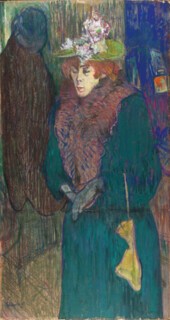Painting and illustration are broad, overlapping provinces. Paintings are (usually) made for walls, illustrations are (usually) printed on paper. There is no need to be pedantic. Illustrations don’t have to have an accompanying text: a Beerbohm caricature, a Rowlandson party at Vauxhall, a Picasso neoclassical nymph and satyr have enough story in them to count as illustrations. Hogarth’s theatrical moralities milked popular sentiment near dry. But at any time before the last peasant was driven from painted landscapes, and while nudes still needed classical passports, nearly all painting that was not topography or portraiture at least hinted at illustration.
When in the 19th century commercial illustrators – war reporters, poster artists, advertisement makers, lithographic cartoonists, Punch illustrators – took to the field and began to represent modern life, a few artists tried running with them. Of those who wanted to get their teeth into it Henri de Toulouse-Lautrec was among the best. His painter/illustrator bilingualism is relevant to Toulouse-Lautrec and Jane Avril, the exhibition the Courtauld has built round a picture from its own collection. (The exhibition closes on 18 September.) The same subject is shown in both portrait and poster modes. The Courtauld’s painting, Jane Avrilin the Entrance to the Moulin Rouge (reproduced here), done in pastel and dilute oil on millboard in 1892, has many of the qualities of a drawing: large flat shaded areas are built up from lines drawn over lines, as though multicoloured rain was falling, and details of the face round the eyes are drawn with the kind of thin, twisted marks that a fine brush and a dilute medium encourage. The thin paint is matt, absorbed by the card – more like gouache than fat oil paint. The colour is sombre: Avril’s coat is dark blue-green, the night-time background blue, purple and brown. The apple green of her hat and its white flowers, her red hair, the chalky pallor of her long, thin face and her red, pursed lips are brightly theatrical, but her expression is contained, the gesture of hands clasped at her waist is ladylike. Unlike La Gouloue (La Gouloue at the Moulin Rouge is also in the exhibition), who stands arm in arm with her sister and her lover with a swing to her hips and a look both ‘impudent and cynical’, the mistress of a way of dancing in which sexual innuendo set the tone, Jane Avril danced a will-o’-the-wisp of the cancan, ‘thin, pale, deliciously agile’.
The exhibition gives us more than one of Lautrec’s Avrils. The Courtauld’s picture, like Jane Avril Leaving the Moulin Rouge (once again oil on cardboard), shows her as a pale passer-by in street clothes. The posters show the performer not just in her famously eccentric costumes but also as the dominant figure in a poster for the Divan Japonais. She sits all in black beside Edouard Dujardin, the famous café-concert’s director and the founder of the Revue wagnérienne. Lautrec matches his marks to Avril’s moods and movements, and the curators have done us a great service in discovering and printing ‘She Who Dances’, a supplement to L’Art français by Arsène Alexandre published in 1893. It is a description of a particular marriage of talents – Lautrec’s and Avril’s – by a critic who admired them both. Only someone who had seen her at work could write as Alexandre does of one of the most famous of the posters, Jane Avril at the Jardin de Paris:
Behind, as if perched on the stage, using the full luminosity of the white paper, appears a pale, elegant and whimsical figure, dressed carefully but individually in a get-up completely in keeping with modern taste, combining something of the costume-ball-baby of days of old, but slimmed down and threatened by the Empire line, and the British ‘tararaboum-de-hay’. Lost in an immense bonnet, in these light, flowing and tumultuous silks, with the thin, fine face of a little working-class rabbit, anaemic and determined, the dancer performs a step that is a must-see – one leg thrown out wildly in front, while her two hands grasp her orange skirt, making it perform grand undulating movements, alternately up and down, following the rhythm, making you think of an orchid in a frenzy.
Frenzy is just what Lautrec’s line gives way to; brush and lithographic ink simplify, exaggerate, set in motion the features and the thin body one knows by quieter representations or by implication in the portraits. That leg ‘thrown out wildly in front’ has its own story. Avril, the daughter of a courtesan, was at first looked after by grandparents and educated at convent schools. Hard times followed for mother and daughter. At 13 she ran away, asked one of her mother’s former lovers for help, was eventually diagnosed with chorea (St Vitus’s dance) and in 1882 entered the famous hospital for neurological diseases, the Salpêtrière. She spent two years as a patient of Charcot’s and claimed that it was there she found her vocation. A party, the bal des folles in which the public mixed with patients, was held each year. There is a group photograph of patients in fancy dress – harlequins, milkmaids, witches, soldiers, a drummer, a clown. There was dancing; she carried on in some kind of trance and found herself applauded. ‘Alas!’ she wrote, ‘I was cured.’ But the movements of her later dance style seem to have evolved from the erratic movements – controlled and otherwise – of her neurological condition, or perhaps that of other women similarly afflicted.
In the posters, the dances, the dancers and the nicknames were the beginnings of the celebrity culture we complain about today. A visit to the Moulin Rouge offered a look at men and women famous for being famous. Photography had a long way to go before the indiscretions of an almost famous person partying in such a place would be illuminated by photographers’ flashguns. In Lautrec’s At the Moulin Rouge (a proper oil painting this, on canvas) Jane Avril’s red hair is the visual, if not the human centre of the table she shares with the wine merchant Maurice Guilbert, the dancer La Macarona, the photographer Paul Sesceau and Dujardin, the man sitting beside her in the poster for the Divan Japonais.
Send Letters To:
The Editor
London Review of Books,
28 Little Russell Street
London, WC1A 2HN
letters@lrb.co.uk
Please include name, address, and a telephone number.


